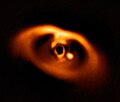References
- ↑ "NASA Exoplanet Archive" . Retrieved 20 December 2019.
- ↑ Campbell, Bruce; Walker, G. A. H.; Yang, S. (1988). "A Search for Substellar Companions to Solar-type Stars". The Astrophysical Journal. 331: 902. Bibcode:1988ApJ...331..902C. doi: 10.1086/166608 .
- ↑ Hatzes, Artie P.; et al. (2003). "A Planetary Companion to Gamma Cephei A". The Astrophysical Journal. 599 (2): 1383–1394. arXiv: astro-ph/0305110 . Bibcode:2003ApJ...599.1383H. doi:10.1086/379281. S2CID 11506537.
- ↑ "The planet-host star Iota Horologii".
- ↑ Kiefer, Flavien (17 October 2019). "Determining the mass of the planetary candidate HD 114762 b using Gaia". Astronomy & Astrophysics. 632: L9. arXiv: 1910.07835 . Bibcode:2019A&A...632L...9K. doi:10.1051/0004-6361/201936942. S2CID 204743831.
- ↑ Dieguez, Flávio. "Terra à vista". Superinteressante (in Portuguese). Archived from the original on 2008-05-15. Retrieved 2008-07-03.
